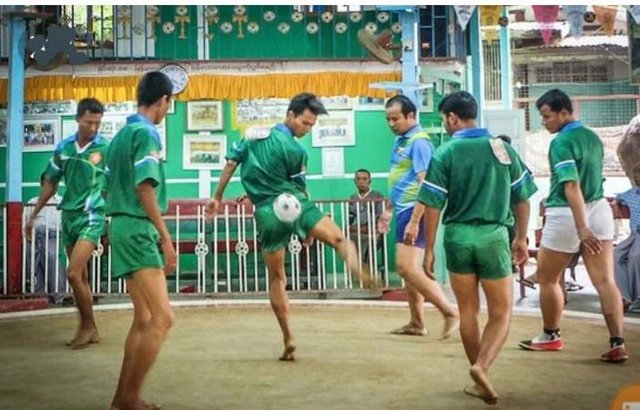Myanmar Sport Chinlone Game

This is Myanmar game. All Myanmar are known that is how to play it.
If you have spent any time in Myanmar, you would probably have seen the usual looking combination of sport and dance known locally as Chinlone, which means “rounded basket”. The sport is said to be over 1,500-years old and was once played by Burmese kings.
Known as “caneball” in English, this essentially non competitive game with no opposing team has no focus on winning or losing, but simply on the manner in which the game is played. You don’t hear that very often in the world of professional sport. Over 200 different methods of contacting the ball have been developed since the game was first invented, some of the most difficult of which are performed “blind” with the ball behind your back.
The game consists of one team of six players who play a version of “keepy uppy” as they pass a woven rattan ball (the distinctive sound made by the ball as it is passed around adds to the aesthetic of the game) around in a circle (typically 22 feet in diameter) using their heads, knees and feet. One player stands in the middle of the circle to perform a solo; various moves reminiscent of dance are combined as the soloist is supported by those in the outer circle. Play stops once the ball has touched the ground before starting again as a new round.
Played barefoot or in specialised shoes on dry, hard dirt (ideally, but any surface will suffice), players use six main points of contact with the ball: the top of the toes; the sole of the foot; the instep and outstep of the foot; the heel; and the knee. Of primary importance in chinlone isform, referring to the correct manner in which the hands, arms, upper body and head should be positioned.
The intensely focused state of mind, said to be similar to that achieved in a Zen state of meditation and which is referred to as “jhana”, is known to be key to a successful performance.
Cultural Importance
Chinlone games play a major part in the country’s almost countless Buddhist festivals each year, the largest of which goes on for a month and features thousands of teams vying for perfect performance of form. Live bands play traditional Burmese music that inspires the players and even shapes the style and rhythm of their play; the game is played in time with the music and the instruments accent the moves.
Played amongst both Myanmar men and women, it’s not uncommon to see ladies and gentlemen in their 80s practicing their form. A solo variety of chinlone called “tapandaing” is not uncommon, but the variant is only played by women.
Origins
The origins of chinlone are thought to be traced to the ancient Chinese game of “tsu chu”, acknowledged by FIFA (football’s world governing body) as being the oldest form of football in recorded history. Similar games are played throughout the region with different styles, rules and balls. There is evidence to suggest that such games traversed the Bering Straits and were adopted by Native Americans, and they are also thought to be the origin of the popular hacky sack style games.
Form takes years to reach the level that is being played at the top of the sport but, as they say, you never know what you can do until you try. It looks difficult and you have probably never even attempted to play anything similar, but that is no excuse for not trying the sport now that you are in Myanmar.

Posted using Partiko Android
အဲကလို ေရးနိုင္တာ ဆိုေတာ့ ေလးစားပီေလ။ ၾကမ္းထွာ ဗ်ာ။
Posted using Partiko Android
Sports tag ရဲ႕ေအာက္မွာ upvote 20 နဲ႔ 30 အထက္ခ်ည့္ျဖစ္ေနလို႔ စမ္းထားတာပါ။ဟိုတစ္စသည္တစ္စေတြပါ အထင္မႀကီးပါနဲ႔ဦး၊ ဒီ tag ကတကယ္အလုပ္ျဖစ္ၿပီဆိုမွတကယ္ေရးမွာပါ
Posted using Partiko Android